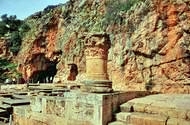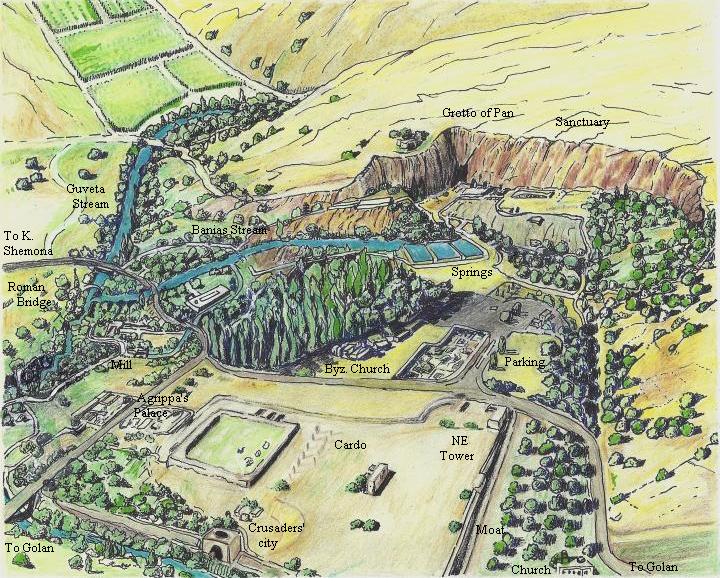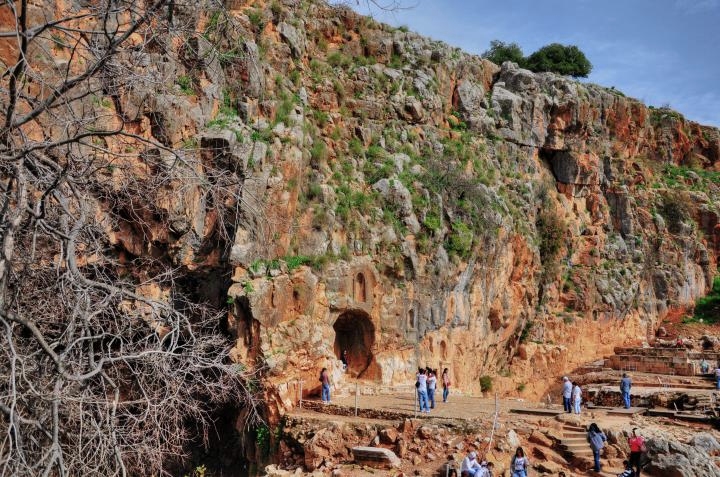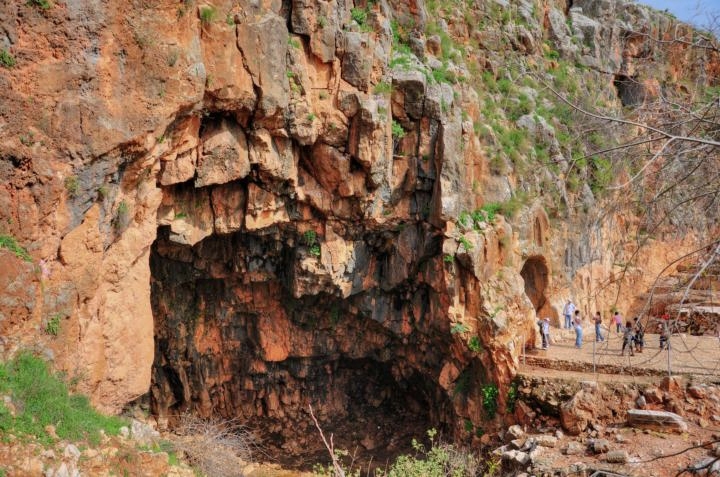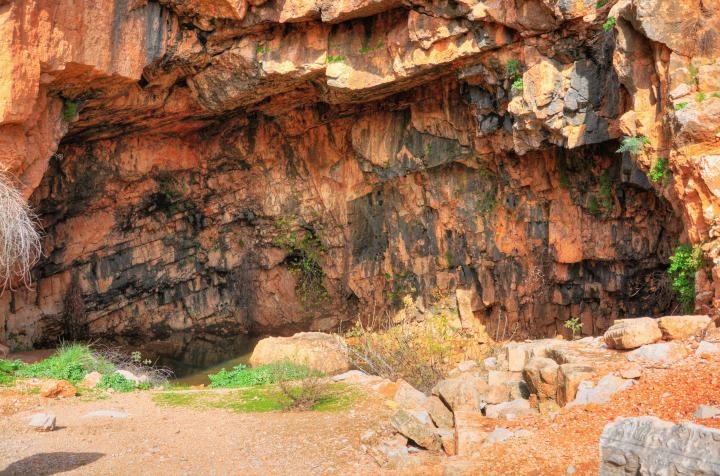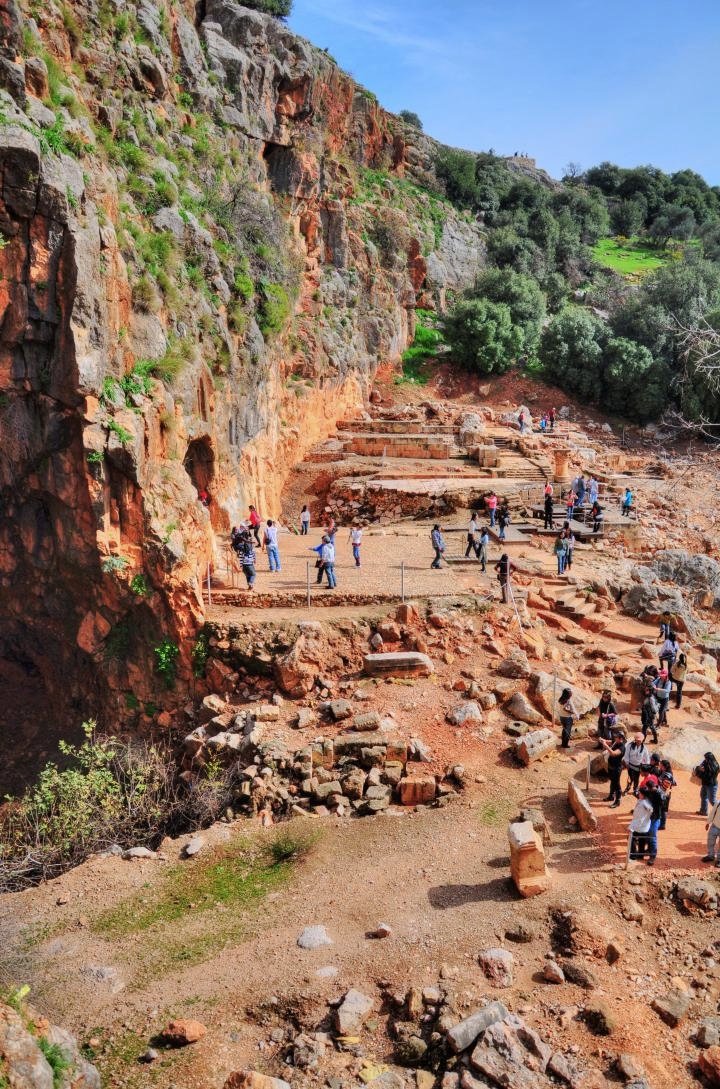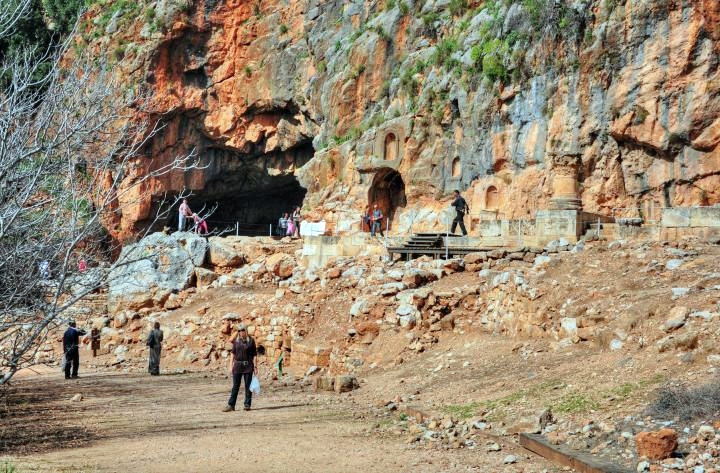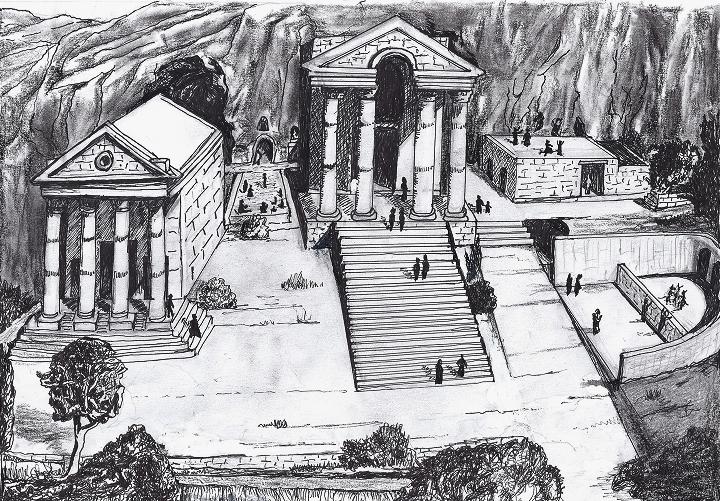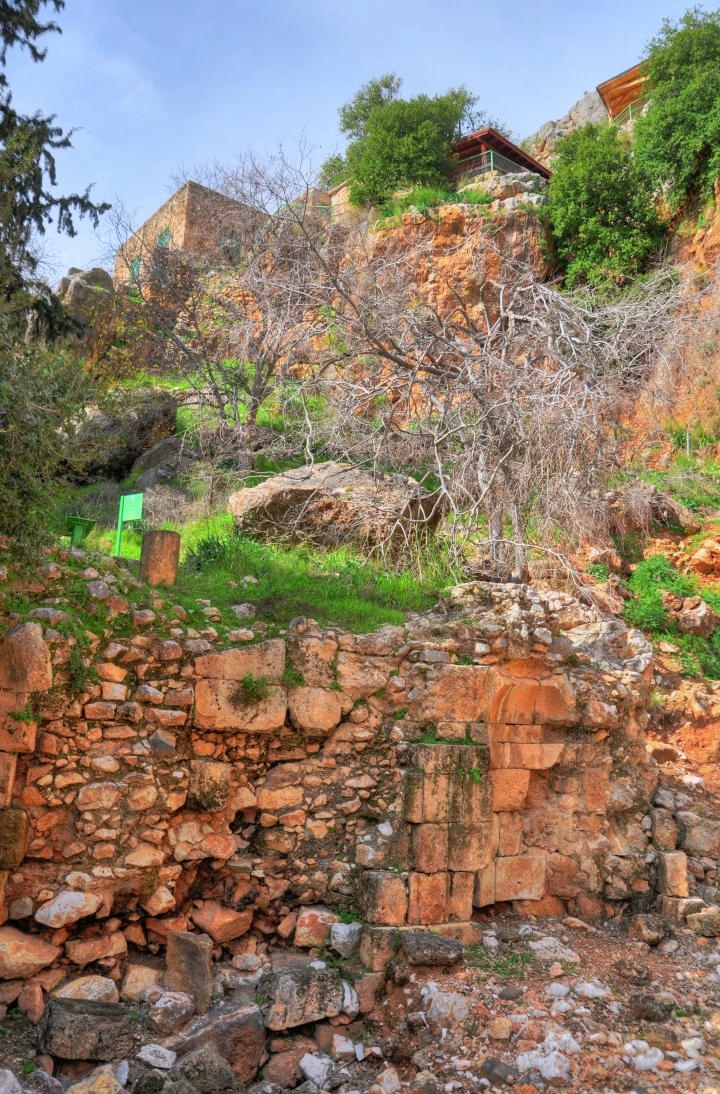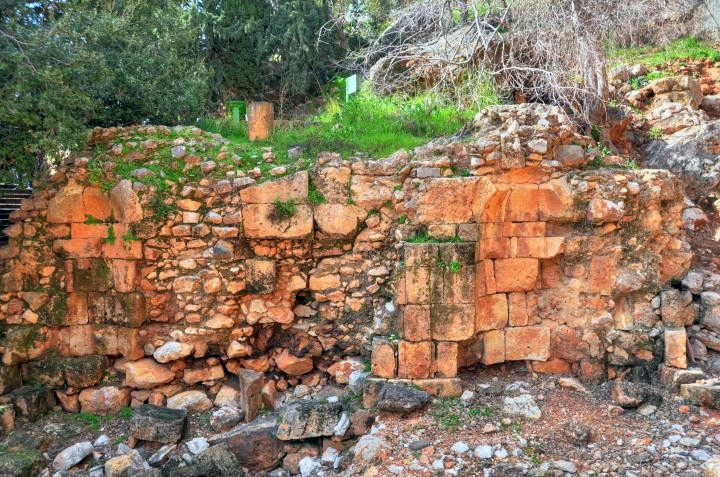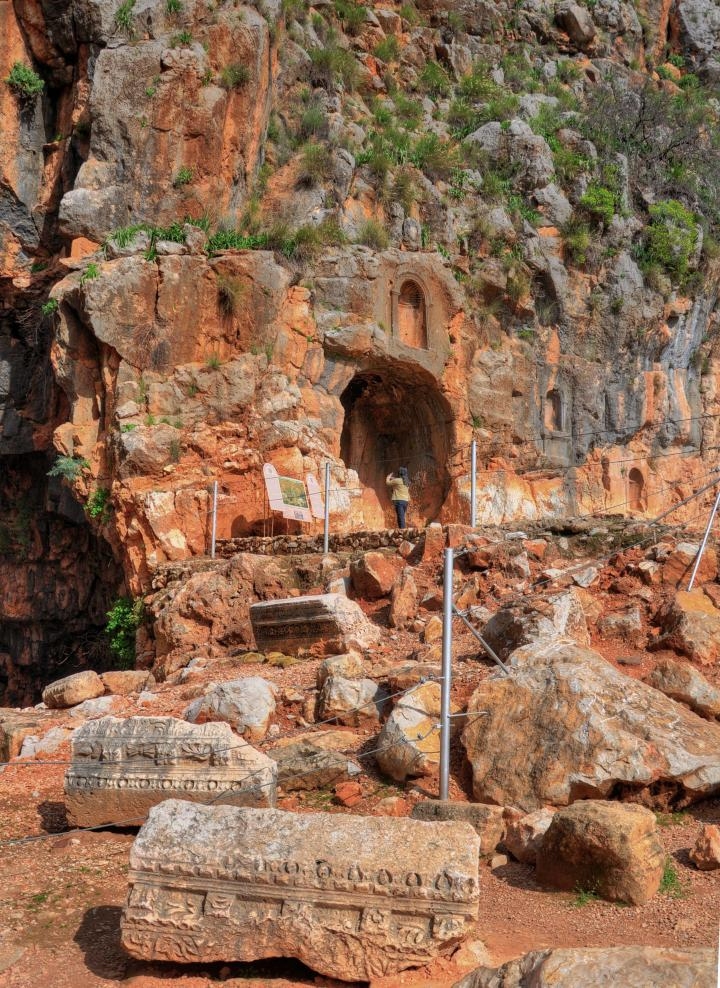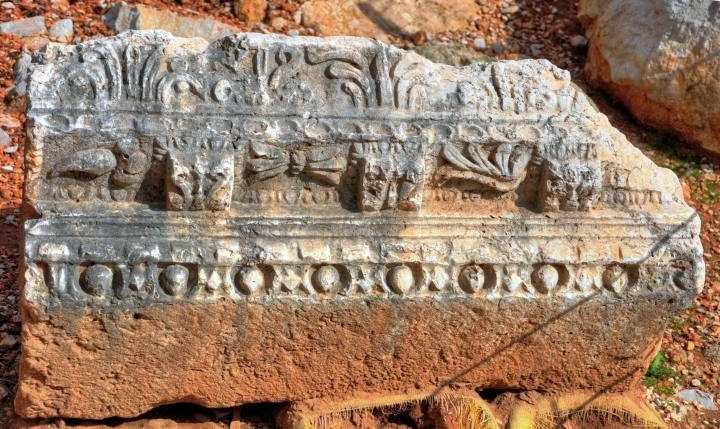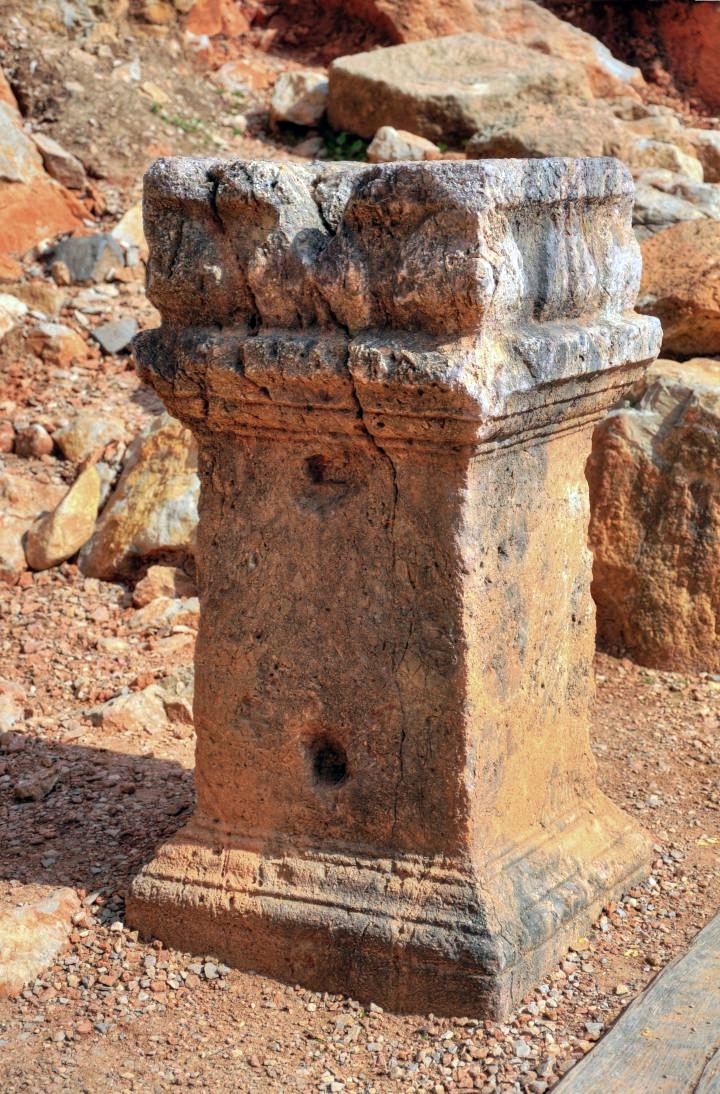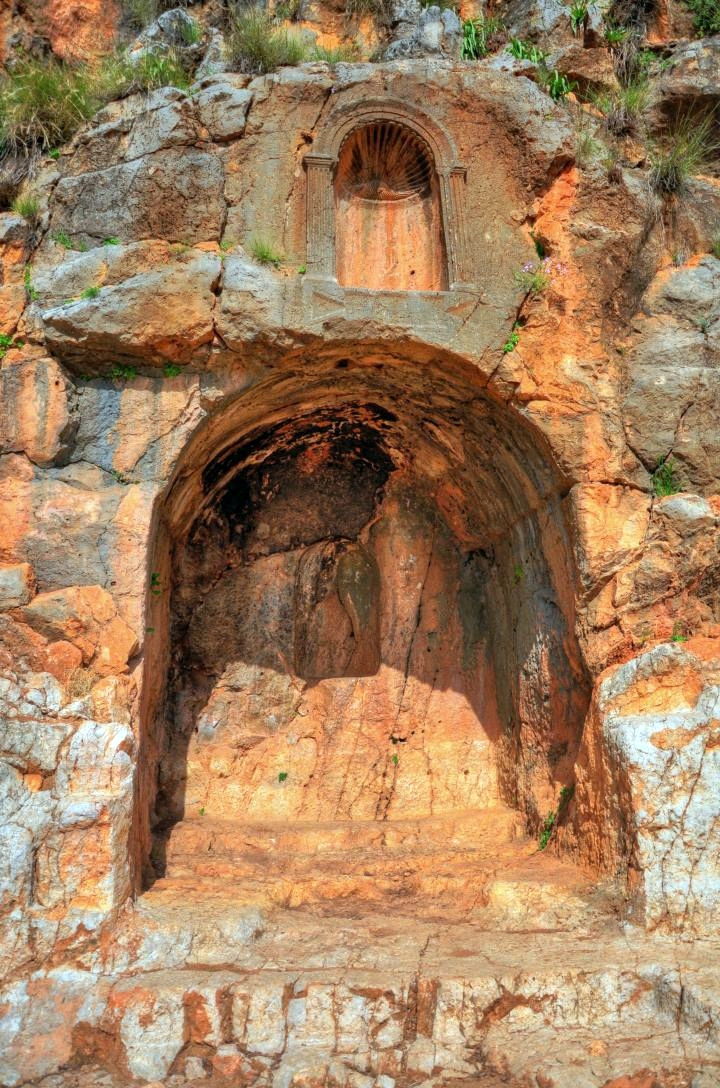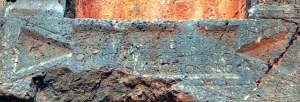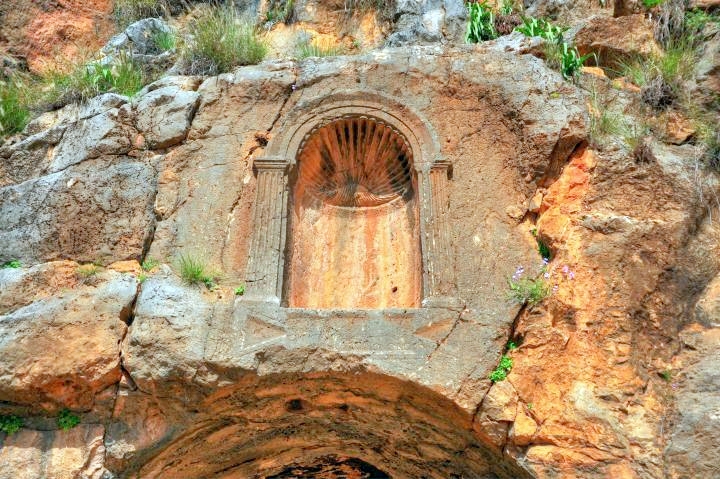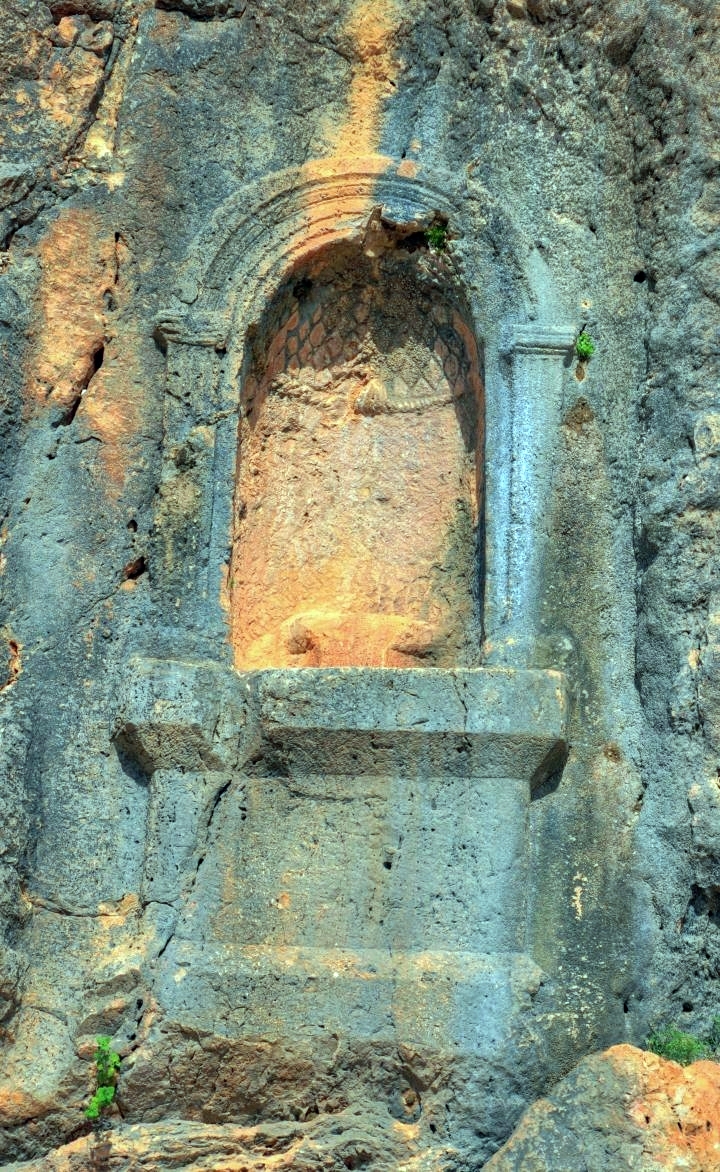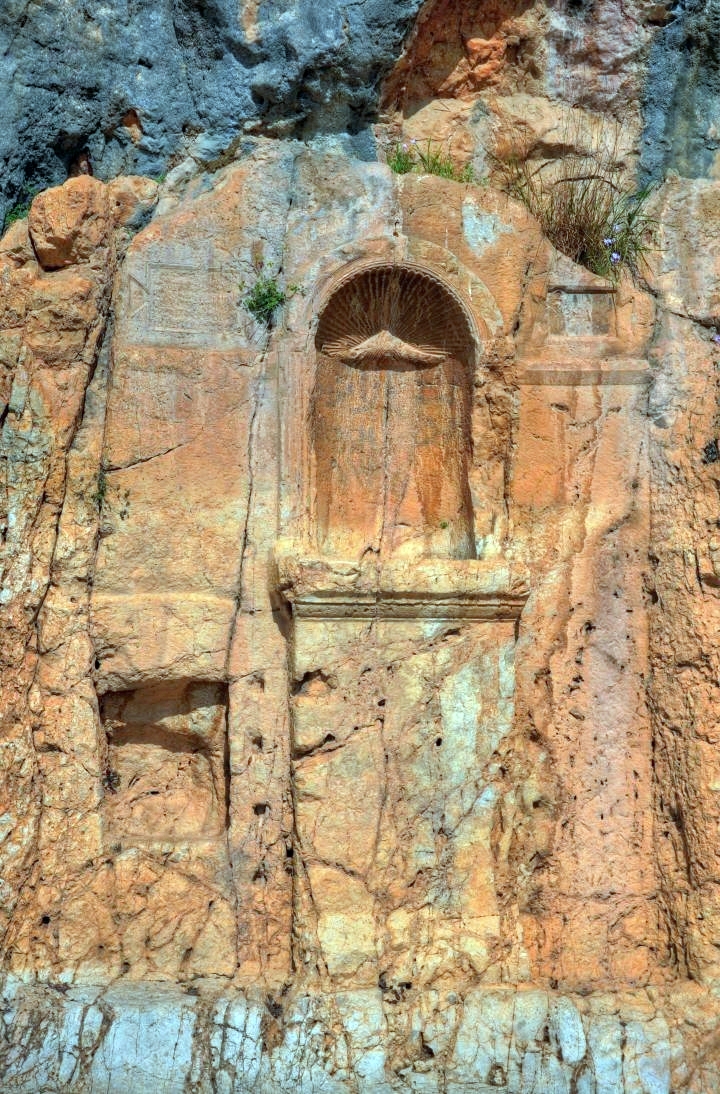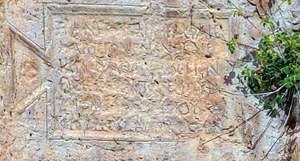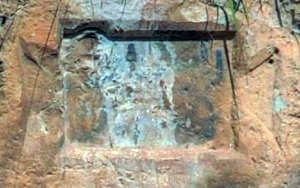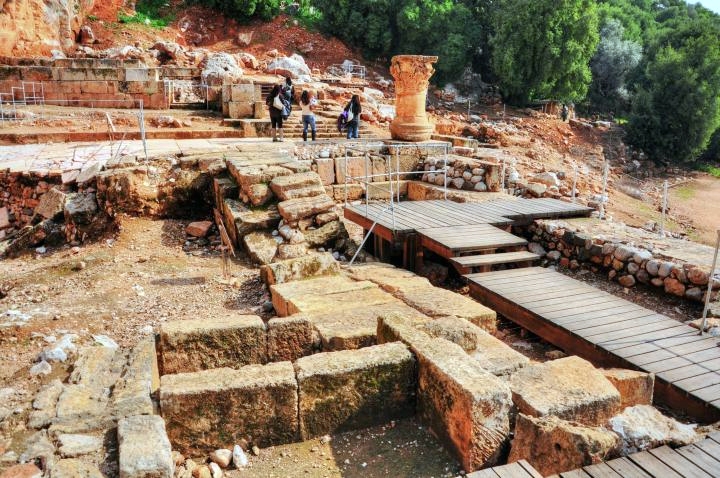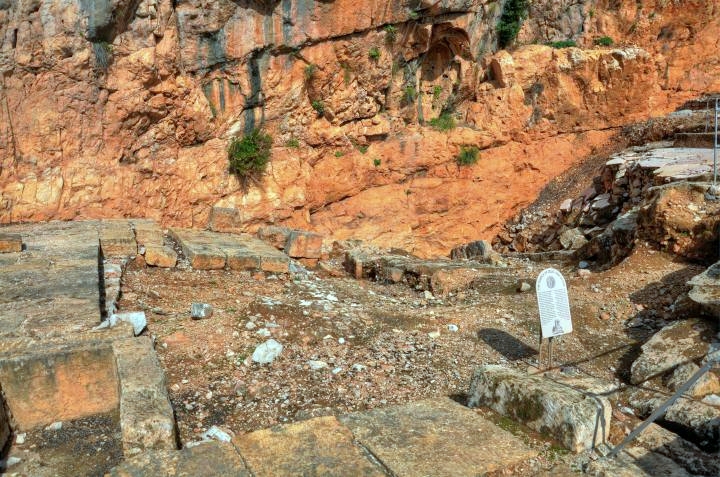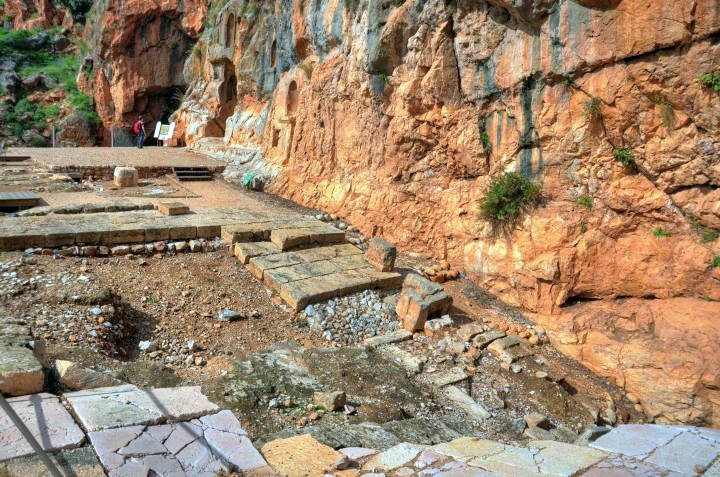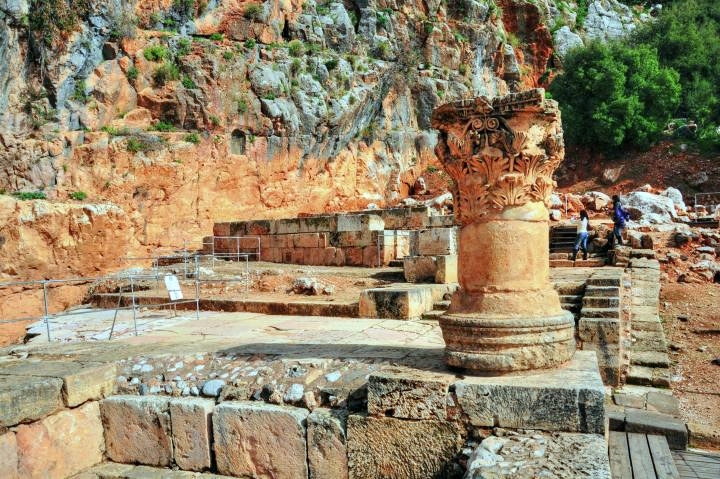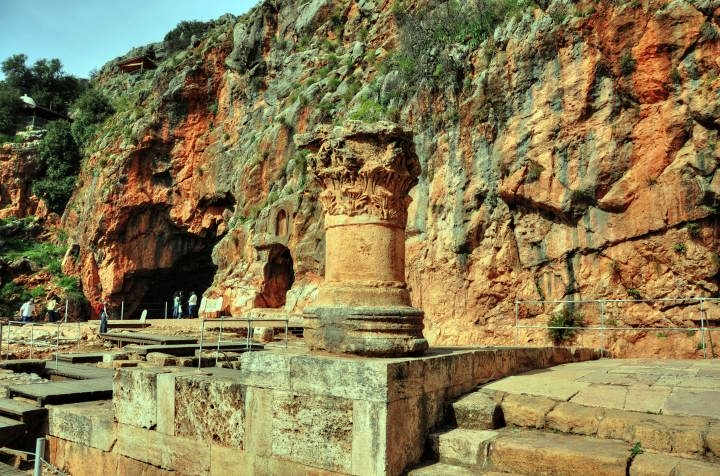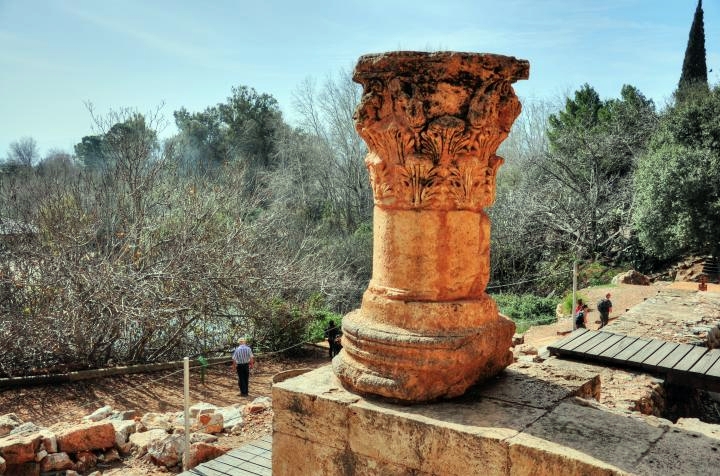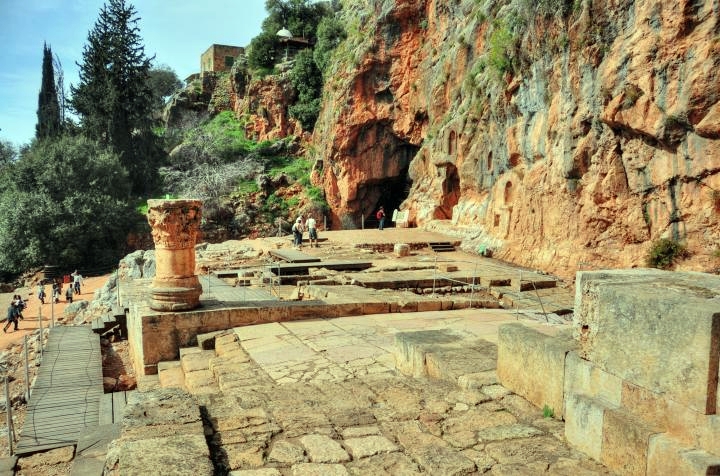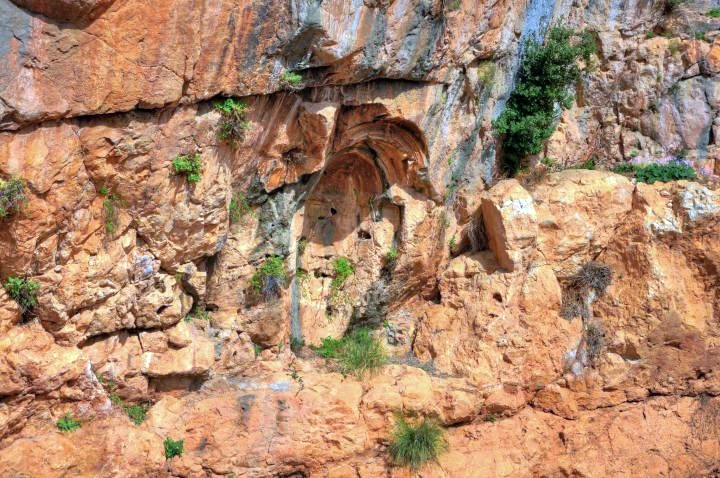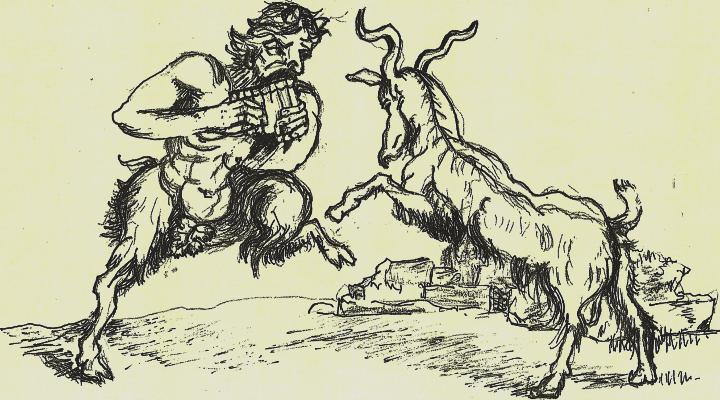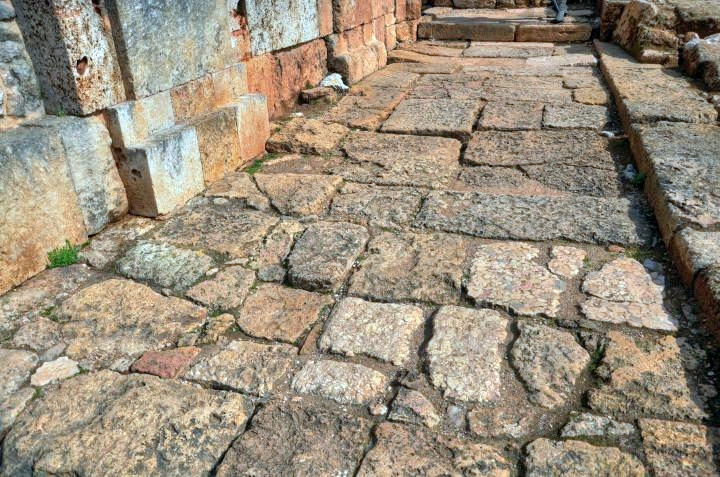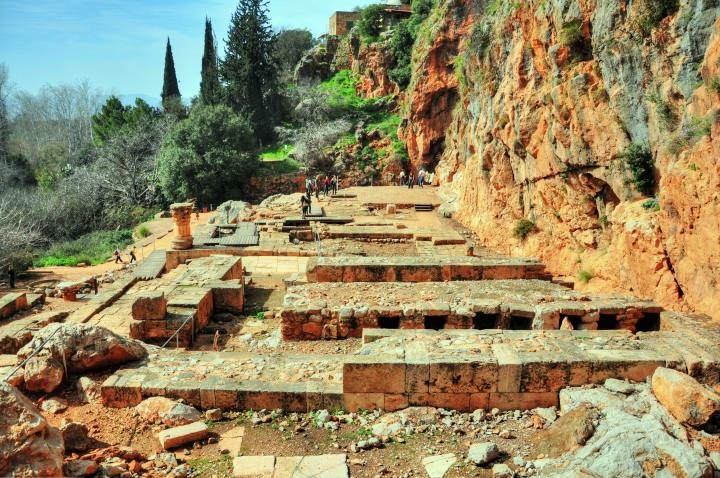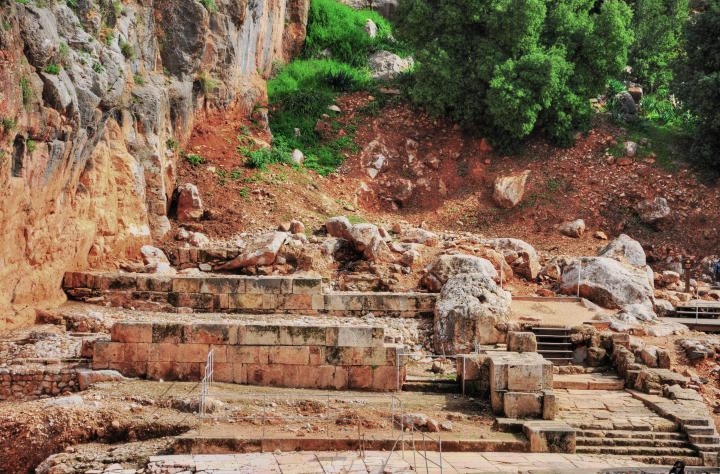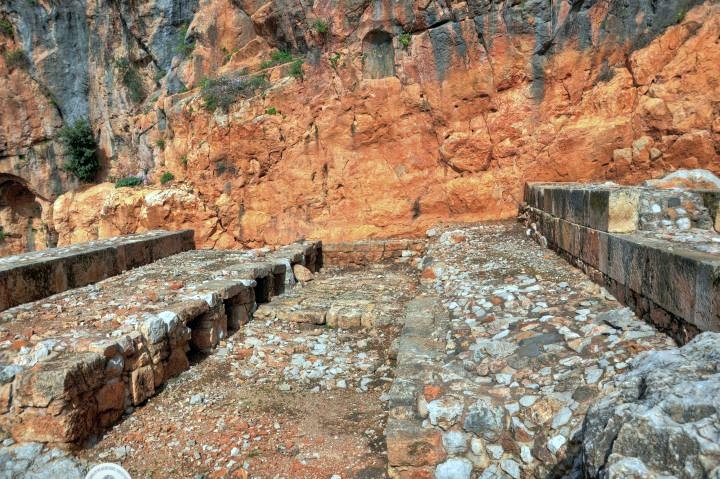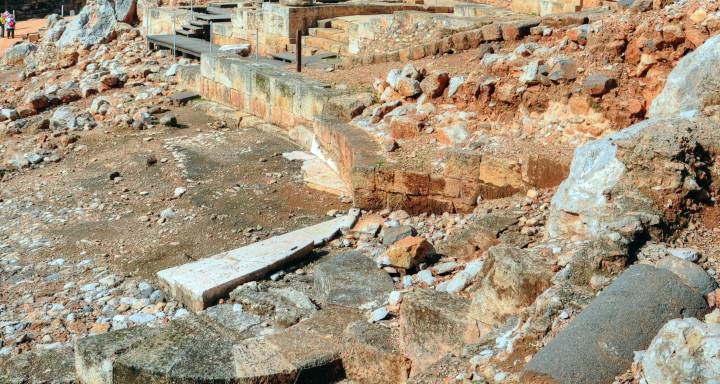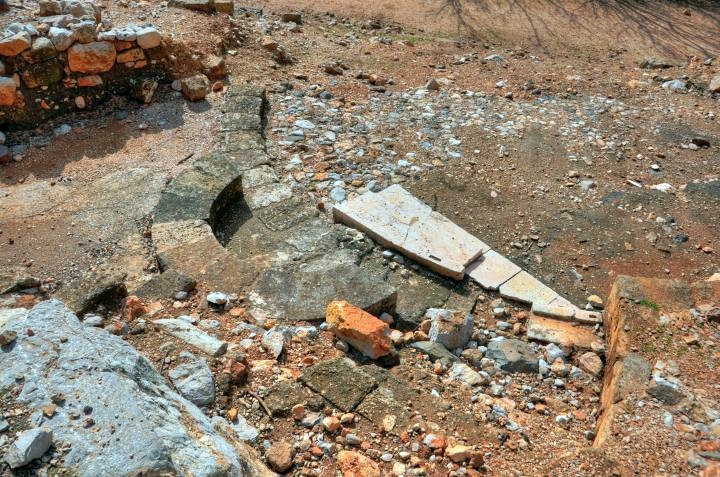A Roman sanctuary, which included temples and ritual courtyards, was built near the sacred grotto of Pan.
Home > Sites > Golan > Banias > Banias Temples
Contents:
Background:
A Roman sanctuary, which included temples and ritual courtyards, was built near the sacred grotto of the Greco-Roman God Pan. The ancient city, named after Pan, was located to the south of the springs.
Josephus (Wars 1 21 3): “… the place is called Panium, where is a top of a mountain that is raised to an immense height, and at its side, beneath, or at its bottom, a dark cave opens itself”.
This page covers the area of the springs and the sanctuary of Pan. For other pages and an overview on Banias – see: Overview page
Location:
Banias is located on the road (#99) that climbs up the Golan heights. The springs are located to the north of the main parking lot. The Sanctuary and the Grotto of Pan are located above the springs.

History of the temples:
This section focuses on the history of the Sanctuary of Pan. For a complete history – check the Banias overview page.
- Hellenistic/Hasmonean Period
The Greek rulers controlled the region following the conquest of Alexander the Great, were impressed by the majestic setting of the area around the springs. The pagan practice of sacrifice at the mouth of the cave started in the 3rd century BC and intensified during the Seleucid control (198 BC).
The Greeks established the new Greek city of Panium (Paneas) south of the springs. The first record of the city was detailed in the great battle near Banias (198 BC) between the armies of the northern Greek-Seleucids, headed by King Antiochus III, and the southern Greek-Egyptians headed by General Scopus. The Seleucids won this battle, giving them a control of the Land of Israel. Josephus (Ant. 12:3 4): “Antiochus overcame Scopas, in a battle fought at the fountains of Jordan, and destroyed a great part of his army”.
The victorious Seleucid King Antiochus III governed the Land of Israel successfully, but under his son Antiochus IV (175-164 BC) relationship with the Jewish population came to an end and resulted in the Hasmonean revolt (167-152 BC). The Hasmonean Jewish Kings first controlled Judea (152 BC-144 BC) and later expanded their control over greater parts of the Land of Israel.
The Roman historian Josephus Flavius wrote that the Golan, the north-east region of Israel, came under Jewish control in the years 83-80 BC. Alexander Janneus’s campaign on the eastern territories, the Hasmonean king captured the Golan (Wars 1:4): “He also demolished Golan, and Seleucia, and what was called the Valley of Antiochus”. (The latter area is the valley west of Banias).
- Early Roman Period
After 20 years, after the Romans annexed the land (63 BC), General Pompey implemented political reformations, which removed the Golan from the Hasmonean state. He reassigned the north-eastern parts to the Itureans, an Arab tribe who received parts of the Galilee and the Golan. The Itureans are referred in Luke 3:1: “Now in the fifteenth year of the reign of Tiberius Caesar, Pontius Pilate being governor of Judaea, and Herod being tetrarch of Galilee, and his brother Philip tetrarch of Ituraea“.
- Herod the Great
Herod the Great, a Jewish Roman client King of Israel (39BC-4BC), subdued the Itureans (23BC) following their inaction against outlaws. As a result, Augustus Caesar gave the northern Golan, including Paneas, to Herod the Great (20BC). Josephus writes about this and added that Herod constructed a temple in honor of his beneficiary (Wars 1 21 3) : “And when Caesar had further bestowed upon him another additional country, he built there also a temple of white marble, hard by the fountains of Jordan: the place is called Panium…”. Additional temples were built in Samaria-Sebesta and in Caesarea-Maritima (“by the Sea”) which is located on the shore in the center of Israel.
The ruins of an Early Roman temple are found on the western side of the sanctuary, close to the cave of Pan, and may be this is the temple honoring Augustus. However, recent excavations identify it in Kh. Omrit which was on the southern entrance to the city.
The illustration below shows the location of the Grotto of Pan and the Sanctuary on the north side of the ruins of the city.
-
Herod’s Son – Philipp
Herod’s 3 sons divided their father’s kingdom, and the Land into 5 regions (years 4BC-6AD) which included Herod’s sister and the area of Hippos controlled by the Syrian King. Herod’s third son, Philipp, also known as Herod II, received the area of Lake Hula, Golan and Bashan. Josephus writes about Philipp (Ant 18 5 4): “Herod [Philip], the son of Herod the Great, who was born of Mariamne, the daughter of Simon the high priest”.
Philipp made Banias his capital city, naming it Paneas-Caesarea, honoring the Roman Caesar Tiberias – son of Augustus. In order to distinguish the name (Caesarea) from the great harbor city of maritime-Caesarea, the northern city was known as “Caesarea-Philippi“. The city was greatly expanded – being the capital of a rich region, and benefitting from the prosperous years under the Romans. Philipp was King until his death (33AD).
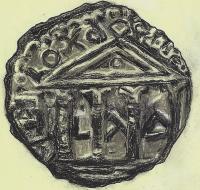
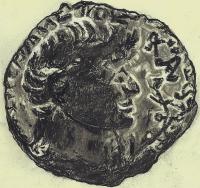
Philipp’s Coin with Tiberias, minted in Banias; dated 31AD
With Tetra-style temple (Augusteum) Drawing by Rina
-
Roman period
The land and the city were inherited in 37AD by the grandson of Herod, Agrippa I, who grew in the Roman royal court. Agrippa received the land as a gift from his childhood friend in Rome – the mad Caesar Gius Caligula (37-41BC). The status of the city declined after Agrippa became King of Israel, since after additional regions were granted from Caligula (37BC-41BC), the King moved his capital to Jerusalem. However, after his son Agrippa II (King 50-95) received the city (53Ad) as a present from Caesar Nero , the city was again rebuilt (61 AD) and in his honor it was renamed “Neronias Caesarea Sebaste” (Ant 20 9 4): “About this time it was that king Agrippa built Cesarea Philippi larger than it was before, and, in honor of Nero, named it Neronlas.”. A grand palace was constructed here to the east of Philipp’s palace, and was recently excavated and reconstructed. The city regained its former ancient name, Paneas, only after 181AD. The city’s Jewish name was “Caesarion” (“little Caesar”), as referred in the 2nd century Jewish religious books of Mishna.
Photos :
(a) Grotto of God Pan:
The Grotto (cave) of God Pan and temples and ritual courtyards around it are seen in the photo. This section is located on an elevated terrace above the springs. This was the sacred place of the city.
Click on the photos to view in higher resolution…
The cliff above the area is 70m long and 40m high, and was probably the rear wall of a giant cave that once collapsed (earthquake of 1033AD), leaving only a fraction of that cave. The cave today is 20m wide by 15m high, and the water level during the winter season corresponds to the level of the springs. The Greeks held that the half-goat, half-man God Pan, lived in this mystical cave.
Josephus writes about this cave (Wars 1 21 3) “… the place is called Panium, where is a top of a mountain that is raised to an immense height, and at its side, beneath, or at its bottom, a dark cave opens itself; within which there is a horrible precipice, that descends abruptly to a vast depth; it contains a mighty quantity of water, which is immovable; and when any body lets down any thing to measure the depth of the earth beneath the water, no length of cord is sufficient to reach it …”.
The depth of the water, according to Josephus, was very deep in ancient times. At his times the springs burst from the opening of the cave. There were also mystical traditions that a tunnel from the cave led deep into the Golan.
Josephus also speculated that the cave receives its waters from Lake Ram (Birkat Ram, Phaila). This theory, although it sounds an absurd, may be scientifically true. Josephus wrote that Philip was the one who found this water link using – quite amusingly – chaff thrown into the lake (Wars 3 10 7): “Now Panium is thought to be the fountain of Jordan, but in reality it is carried thither after an occult manner from the place called Phiala: this place lies as you go up to Trachonitis, and is a hundred and twenty furlongs from Cesarea, and is not far out of the road on the right hand; and indeed it hath its name of Phiala [vial or bowl] very justly, from the roundness of its circumference, as being round like a wheel; its water continues always up to its edges, without either sinking or running over. And as this origin of Jordan was formerly not known, it was discovered so to be when Philip was tetrarch of Trachonitis; for he had chaff thrown into Phiala, and it was found at Paninto, where the ancients thought the fountain-head of the river was, whither it had been therefore carried [by the waters]. As for Panium itself, its natural beauty had been improved by the royal liberality of Agrippa, and adorned at his expenses. Now Jordan’s visible stream arises from this cavern…”.
(b) The temples:
A general view of the cliff to the side of the cave is shown in the following picture. A number of temples and ritual courtyards are located around the cave. The Greeks sanctified the cave and dedicated it Pan, the God of shepherds and flocks, mountainside, hunting and rustic music. This gave the city its name – Panium or Panias – which is pronounced in Arabic as Banias.
The cave of Pan became a center of pagan activity starting from the Hellenistic period (from 3rd century BC). Animal sacrifices were thrown into the cave. The sanctuary received a higher status after Herod constructed a temple in honor of Augustus (16 BC). Additional temples and rock-hewn niches and inscriptions were added. The pagan activity continued until the middle of the Byzantine period, around the 5th century AD, and then they were abandoned.
The picture below, a view from the south-east, shows the grotto of Pan on the left side and the temples on the right side.
A reconstructed view of the temples is illustrated below.
Drawing by Grandma Rina
Each one of the temples, and courts between the temples, are detailed below. Their order is from left to right, which also follows the order of the construction (16BC to 220AD)
(c) Temple of Augustus:
The temple of Augustus is the most western temple in the complex of the temples. Its position in the area of the sanctuary is marked on the illustration.
The photo below shows the edge of the temple, with a section of the temple’s wall. Above the cliff is the grave of Nebi Khader (“The Green One”), the holy man (prophet Elijah) for the Druze and Muslims.
The temple of Augustus (“Augusteum”) was constructed in 16BC by Herod the Great, as a gratitude to Caesar Augustus who gave Herod the land of Golan as a present (20BC). Josephus writes about the construction (Wars 1 21 3): “And when Caesar had further bestowed upon him another additional country, he built there also a temple of white marble, hard by the fountains of Jordan…”.
Was the temple near the cave of pan the same one Josephus described? There are debates between scholars, and a recent excavation in the nearby Kh. Omrit has discovered a more likely candidate for the Augusteum.
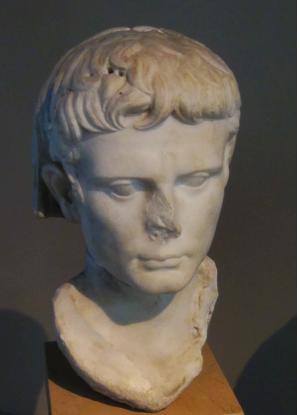
Bust of Augustus Caesar (reign 27BC – 14 AD)
The semicircular and rectangular niches in the face of the western wall used to house the statues of the deities in the Roman temple.
A passage from the temple to the Grotto of Pan (the holy cave on the left side below) was located on the rear side of the temple.
The carved stones seen above and below decorated the passage to the cave.
Another decoration from the temple of Augustus.
(d) Court of Pan & The Nymphs:
East of the Grotto of Pan is the court of Pan & the Nymphs. Its location between the two temples is indicated on the illustration.
A decorated niche, hewn into the wall of the cliff where the Pan’s statue once stood. Above the niche is a smaller semi-circular niche with scallop-shell decoration inside, as seen in the picture underneath.
Between the large and small decorated niches is a 4-line Greek inscription. This inscription is dated to the year 150 (counting from Pompey’s entry at 63 BC, which means 87 AD). It reads: “Dedicates to Pan, son of Diopan (the lover of tunes) who loves Ekho (name of a nymph) – (by) The priest Victor, son of Lysimachus”.
Another niche is located a few meters away, with a rock-hewn pedestal underneath. This niche may have been also the place of Pan’s statue, or his father Hermes (the messenger God).
And another niche is located to the right, a semi-circular niche with a shell decoration inside its top:
A closer view of the inscriptions –
(e) Temple of Zeus:
The temple of Zeus – The King of Gods in the Greek mythology – is located in the center of the sanctuary, as illustrated here.
This grand temple was constructed in the period of Trajan (Caesar 98-117AD), during the celebrations of 100 years after its founding. A marble inscription found in the site implies the temple is for Pan and for Zeus of Heliopolis (City of the Sun, aka Baalbek in Lebanon).
The following picture shows the rear side of the temple of Helipolitan Zeus. The Sun God was also called Jupiter Baal.
Another view of the rear side of the temple of Helipolitan Zeus (in the center).
One of the four capitals of the temple survived and stands on its south-east corner.
Another view of the Corinthian capital and the temple. The temple was depicted on the coins of the city, with four columns and the status of Zeus in the center.
Yet another view … (couldn’t resist to see all sides…)
(f) Court of Nemesis:
Nemesis, goddess of Roman Imperial justice and vengeance, was honored by a long but narrow court located at the east side of the temple of Zeus.
The court was built in 178AD. Its paved floor is arranged in a checker pattern of white and pink stones, seen connecting the stairs to the face of the cliff.
A large niche embedded in the wall at the end of the court used to hold the statue of Nemesis behind an iron grate.
A Greek inscription above the niche (seen in detail here) tells of the goddess Nemesis and the donor.
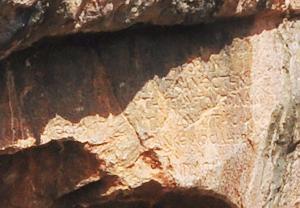
(g) Temple and tomb of the sacred goats:
At the eastern side of the sanctuary are two temples, associated with the unique cult of “dancing goats“.
The upper structure is the “Tomb temple of the dancing goats”, while the lower structure is the “Temple of “Pan and the dancing goats”.
Pan, according to Greek Mythological, has the appearance of half goat (lower body) and half human. His pipe-playing entertained dancing goats, hence the source of the “dancing goats” temples.
Drawing of Pan and Dancing Goat – by Grandma Rina
A paved floor leads from the court of Nemesis to the temples of the dancing-goats:
The first of the two temples dedicated to the dancing goats is actually a tomb complex – seen on the bottom of the picture – where the goats were buried.
Another view of the tomb temple of the sacred goats (from the west side):
The tombs of the goats from a closer view. This temple-tomb was constructed in 220AD during the period of Caesar Elagabalos. The bones of the goats were placed into the burial chambers seen below, together with the offerings of pottery, glass vessels and coins which were brought to the temple. A niche is seen behind, on the wall of the rock.
Another temple, at a lower level than the tombs, is the temple of “Pan and the dancing goats“. Only its northern section was reconstructed. The temple has a semicircular shape in both its external wall (seen in the upper center) and a smaller apse in the center of the wall.
Another view of the base of the temple of the dancing goats. The temple was constructed at about 220AD, and appears on the city’s minted coins.
Etymology (behind the name):
* Names of the city-
- Paneas – The city of Pan – Greco-Roman God of shepherds and flocks, mountainside, hunting and rustic music
- Panias, Panium, Panaeon – other forms of “city of Pan”
- Banias – the Arabic name of the village – preserved its name
- Caesarea-Philippi – Caesarea is the city of Caesar; Philippi – named after Herod’s son who made the city is capital
Links:
* External links:
* Internal links:
- Kh Omrit
- Banias Overview page
- Banias stream
- Banias Roman/Byzantine city
- Banias Crusaders city
- Peter and Pan – exhibition in Israel Museum
* Books:
- Caesarea Philippi: Banias, the lost city of Pan [2004] – John Francis Wilson
BibleWalks.com – have Bible will travel
Banias (Overview) <<<–previous site—<<<All Sites>>>—Next Golan site —->>> Banias stream
This page was last updated on July 6, 2019 (Peter Pan exhibition)
Sponsored links:
